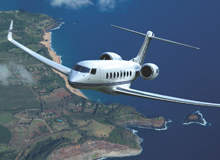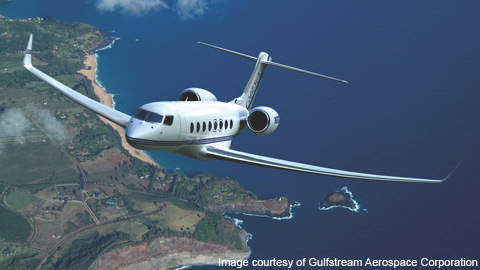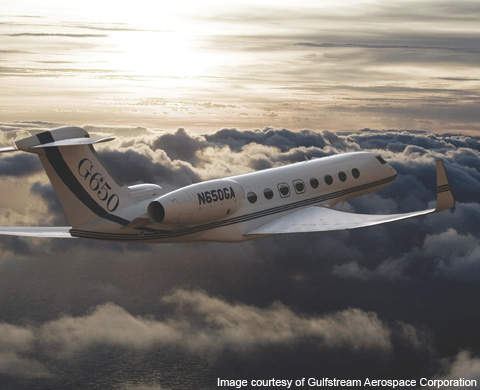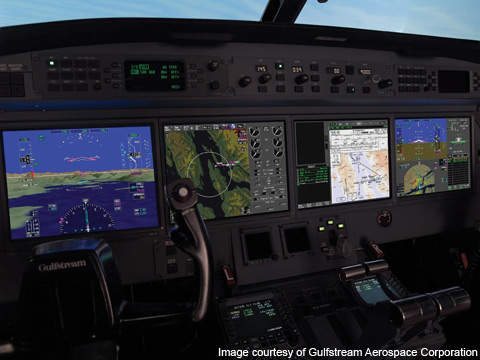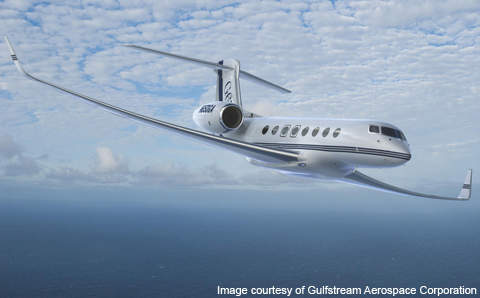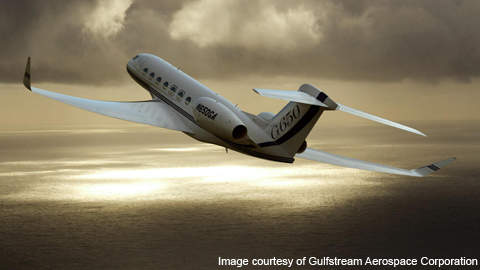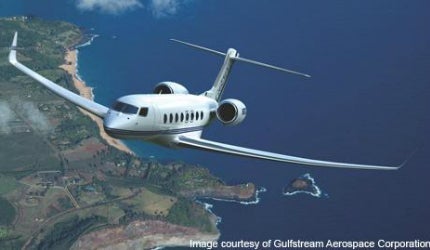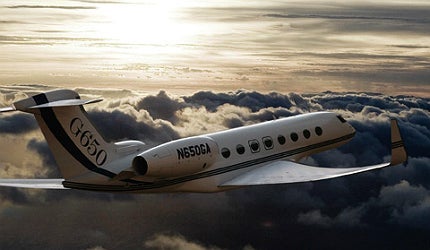The Gulfstream G650 comes with ultra-high speed, ultra-long-range features and is the most expensive business jet manufactured by US-based Gulfstream Aerospace Corporation. The G650 project started in May 2005 and was unveiled in March 2008. The prototype of the G650 was rolled out on 29 September 2009 at Gulfstream’s 308,000ft² manufacturing facility in Savannah, Georgia, US.
The maiden flight of the G650 jet liner took place on 25 November 2009 and the first series of flight tests was completed in December 2009.
Gulfstream completed the limit load testing of the G650 in May 2010 for FAA and the EASA approvals. The tests were conducted on primary structural components encompassing the fuselage, wings, horizontal and vertical stabilisers, landing gear and flight control surfaces.
CPI Aerostructures signed a contract with Spirit Aerosystem in November 2010 to supply cutting-edge assemblies for incorporating in the G650 aircraft.
On 2 April 2011, a G650 flight-test aircraft crashed during take-off performance tests. The accident, which occurred in Roswell, led to the death of two pilots and two flight test engineers onboard.
The aircraft received its type certification from the Federal Aviation Administration (FAA) in September 2012. The production certificate from the FAA was received in December 2012. The aircraft also received type certification from the European Aviation Safety Agency (EASA) in December 2012.
Orders and deliveries of G650 aircraft
As of September 2012, Gulfstream Aerospace Corporation received orders for 200 jet liners and 400 letters of intent for the G650. In March 2009 JPMorgan Chase announced plans to purchase two G650 business jets.
About $138m has been earmarked by JPMorgan Chase for buying the jets and renovating a hangar at Westchester Airport to house them. Of the $138m, approximately $120m will be spent on the jets themselves, while the remaining $18m will be used to renovate the hangar. Gulfstream started delivering G650s to customers in December 2012. The first jet was delivered in December 2012, to a customer based in the US.
Design of the Gulfstream G650
The G650 was designed using three-dimensional electronic tools. It is a long-range jet and has a larger cabin than other business jets in its class. The G650 can also land at smaller airports.
The G650’s fuselage cross-section is oval-shaped with a flatter lower portion. The surfaces are completely controlled by fly-by-wire technology. The wing was designed in 2006. The wing-tunnel testing was completed at the end of 2008.
Development and testing of a pressure test fuselage, which includes ultimate pressure testing of 18.37psi, has also been completed.
Features of the G650 jet liner
The G650 is equipped with satellite phones and wireless internet. It also features a water treatment facility, IWG-A6, manufactured by International Water-Guard Industries (IWG) of Canada. The unit is capable of providing water treatment for an entire Boeing 737 or Airbus A320 aircraft.
A flow rate of about 4gal/min can be produced by the 10lb water treatment unit on board. The treatment unit combines ultraviolet disinfection with a replaceable filter to generate clean water from on-board supplies. It also has an improved self-monitoring system.
The G650’s electrical power system components include two 40kVA integrated drive generators and a 40kVA APU generator. The G650 carries a 15kVA ram air turbine, which offers greater electrical power capacity, uninterrupted power transfer capability and added redundancy for safe and reliable operation.
A safety flight test for the secondary power distribution system of the G650 was completed in October 2009 by GE Aviation. The power distribution system employs modular and solid-state power tiles that minimise installation weight and volume. The system architecture reduces its overall weight.
US-based aerospace equipment manufacturer NORDAM Group is supplying the main landing gear doors and 20 composite wing-to-body fairing panels extending 46ft. Gulfstream Aerospace Corporation awarded a $100m contract for the work to NORDAM in 2007. On 3 November 2009 NORDAM delivered the first two panels and six hinged main landing gear door shipsets for final assembly.
Fuselage and flight deck onboard
Bonded skin panels, machined frames and precision assembly were employed in the design and manufacturing processes of the G650’s fuselage. These methods reduce assembly time and energy consumption.
The fuselage is made from metal, while the tail assembly, winglets, rear pressure bulkhead, engine protective sheet and cabin floor structure are made with composites.
The G650 is equipped with second-generation enhanced vision system II (EVS-II) equipment, which included the head-up display II (HUD II), runway awareness and advisory system (RAAS) and synthetic vision-primary flight display (SV-PFD). These features offer higher levels of safety.
The EVS and SV-PFD help pilots monitor terrain, obstacles and approaches in bad weather conditions. Real-world images are captured by EVS’s forward-looking infra-red (FLIR) camera and displayed on the HUD II in the cockpit.
The jet liner is also fitted with a Plane View II cockpit, which includes a Triplex Flight Management System, four 14in liquid crystal displays (LCDs) and interactive network active-traffic visualisation (INAV).
G650 is powered by two Rolls-Royce Deutschland BR725A1-12 turbofan engines
It also has an integrated engine indicating and crew alerting system (EICAS), system displays, dual automatic flight control systems, automatic emergency descent mode and a 3-D scanning weather radar (RDR-4000).
The cockpit also has a dual radio system with a third NAV / COM communication management function and a central maintenance computer. Fly-by-wire technology has been implemented in the jet’s advanced flight control system, reducing stress on the airframe.
Cabin of the ultra-high speed jet liner
The G650’s cabin incorporates recommendations from fleet operators. The fuselage length of the cabin has been increased by 24in, while the width and height have been increased by 14in and 3in respectively when compared with the Gulfstream G550.
The size of the windows has been increased by 20.5in. The volume of the cabin is 60.51m3. The length and height of the G650 cabin are 16.33m and 1.95m respectively, while the width is 2.59m.
The cabin has improved on-board lighting and an advanced communication system. To provide more leg room, the length of the living area has been increased. The new cabin width allows wider seats to be accommodated and provides more aisle space.
A stateroom occupies the remaining space in the cabin. It has a seat, a divan that becomes a double bed, a 26in pop-up LCD monitor and two windows on each side.
Avionics on the G650 aircraft
In March 2008 Honeywell was awarded a $3bn contract by Gulfstream Aerospace Corporation to supply avionics and mechanical systems for the G650.
Honeywell has provided a next-generation flight management system (NGFMS) that features path guidance, required time of arrival (RTA) and display of engine-out drift-down and curved-path transitions. The avionics supplied by Honeywell also include dual 5in LCD standby multifunction controllers (SMCs), triple Laseref VI inertial reference systems and an MCS-7120 satellite communication system (SATCOM).
Engines and performance of Gulfstream’s business jet
The G650 is powered by two Rolls-Royce Deutschland BR725A1-12 turbofan engines, which together generate 143.2kN of thrust at take-off. Manufactured in Germany, the BR725A1-12 engine has been principally developed for ultra-long range business jets. The engine entered service in December 2012 through the G650.
The BR725A1-12 engine offers high thrust, a large payload, better fuel efficiency, clean and quieter operation and longer maintenance intervals. It is equipped with a 50in swept fan composed of 24 titanium blades for enhancing aerodynamic flow and efficiency and reducing noise and emissions.
The G650 can travel up to 12,960km at 904km/h. The maximum and cruise speeds are 982km/h and 957km/h respectively. It can climb to an altitude of 51,000ft to avoid traffic and inclement weather.
The maximum take-off weight is 47,179kg. The wing loading and cabin pressurisation are 77.7lb/ft² and 10.7psi respectively. The take-off distance and cruise range are 1,829m and 9,260km respectively.
Related content
Gulfstream G280 Super Mid-Size Business Jet, United States of America
Gulfstream G280 (earlier called the G250) is a super mid-size business jet designed and manufactured jointly by US-based Gulfstream Aerospace and Israel Aerospace Industries (IAI).
Gulfstream G150 Mid-Size Business Jet, United States of America
Gulfstream Aerospace Corporation, based in Savannah, Georgia, announced the wide-cabin, high-speed G150 business jet in September 2002.
Best in the Business: the leading corporate jets
Innovation in the business jet market remains evident, despite post-recession recovery proving more elusive.

